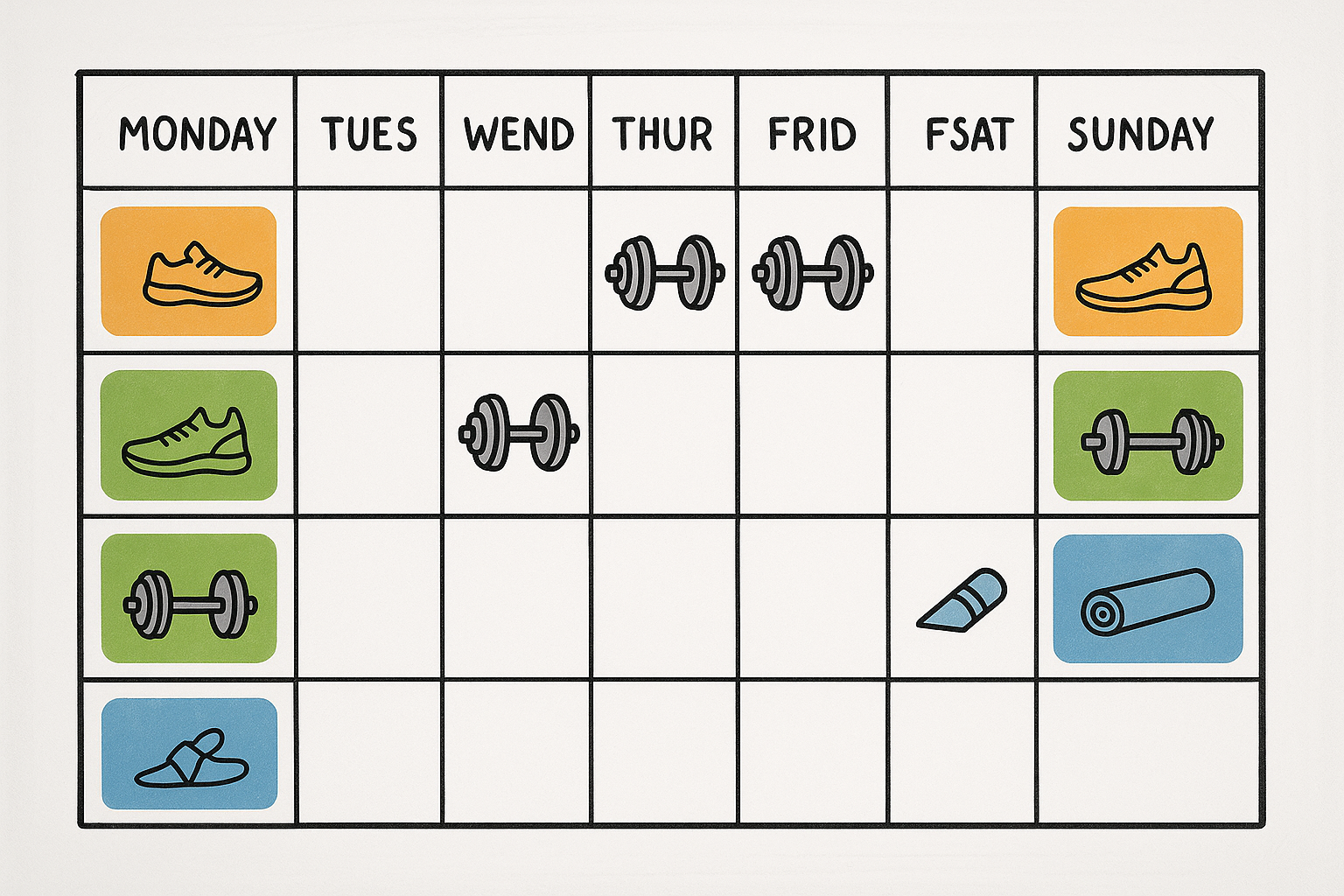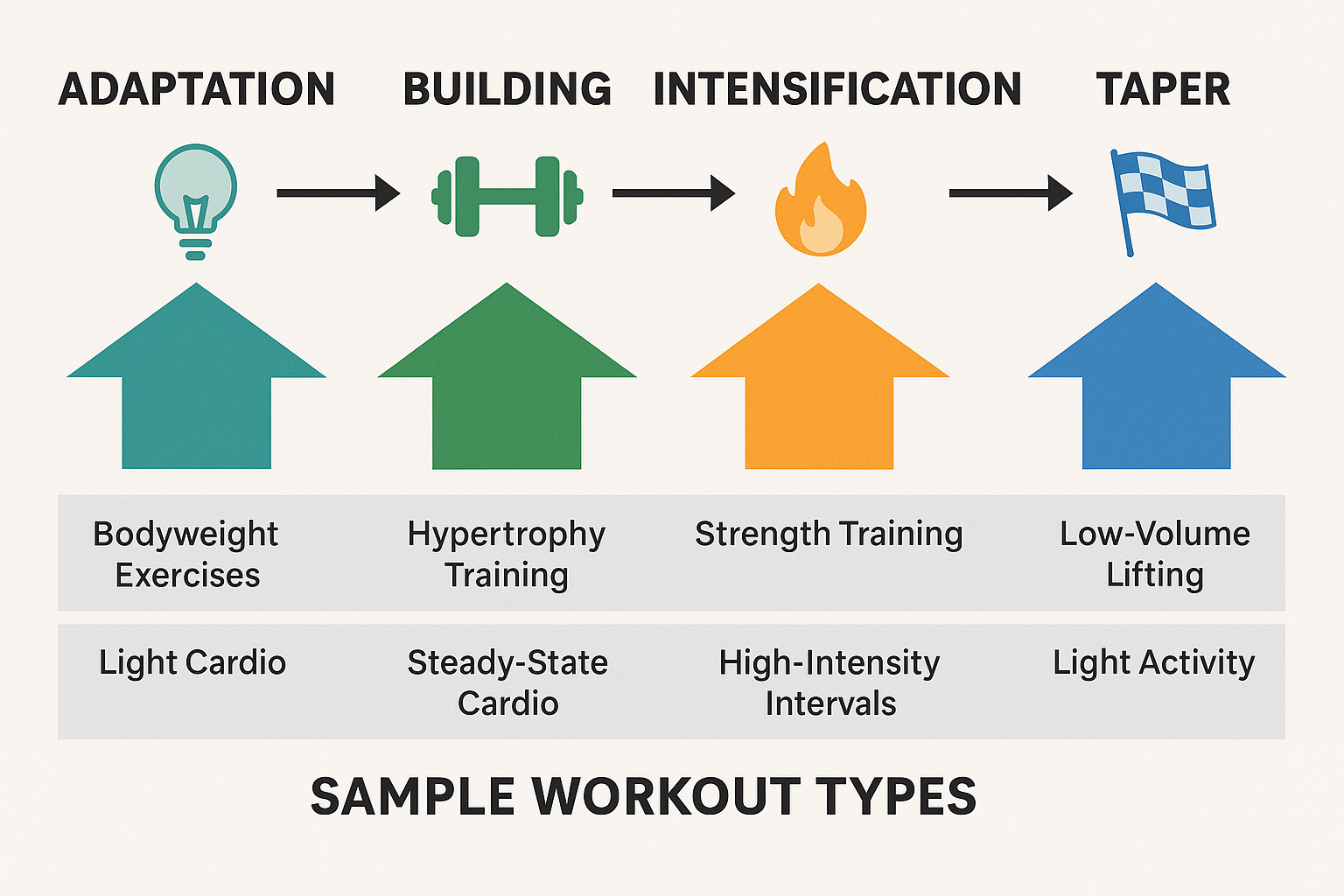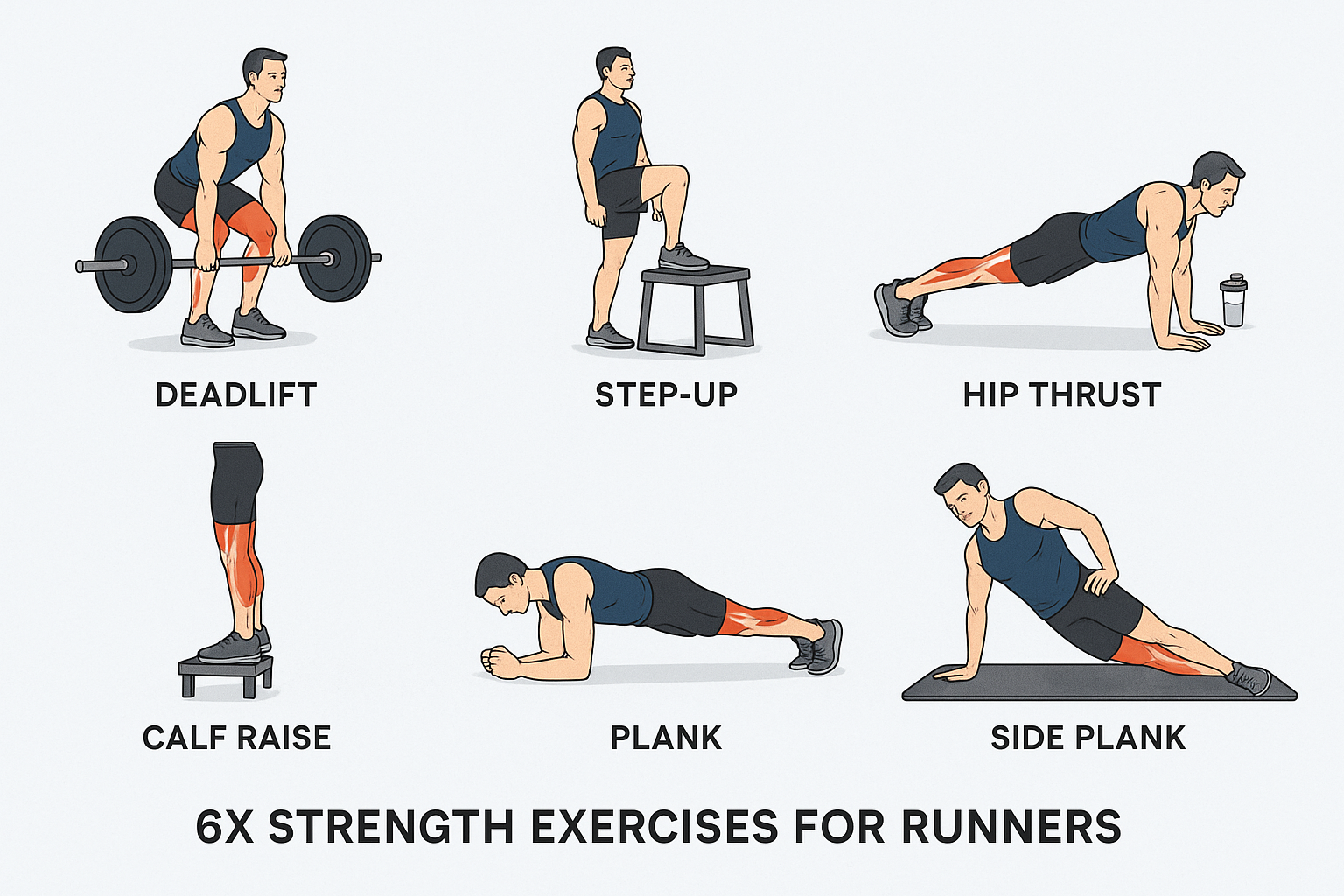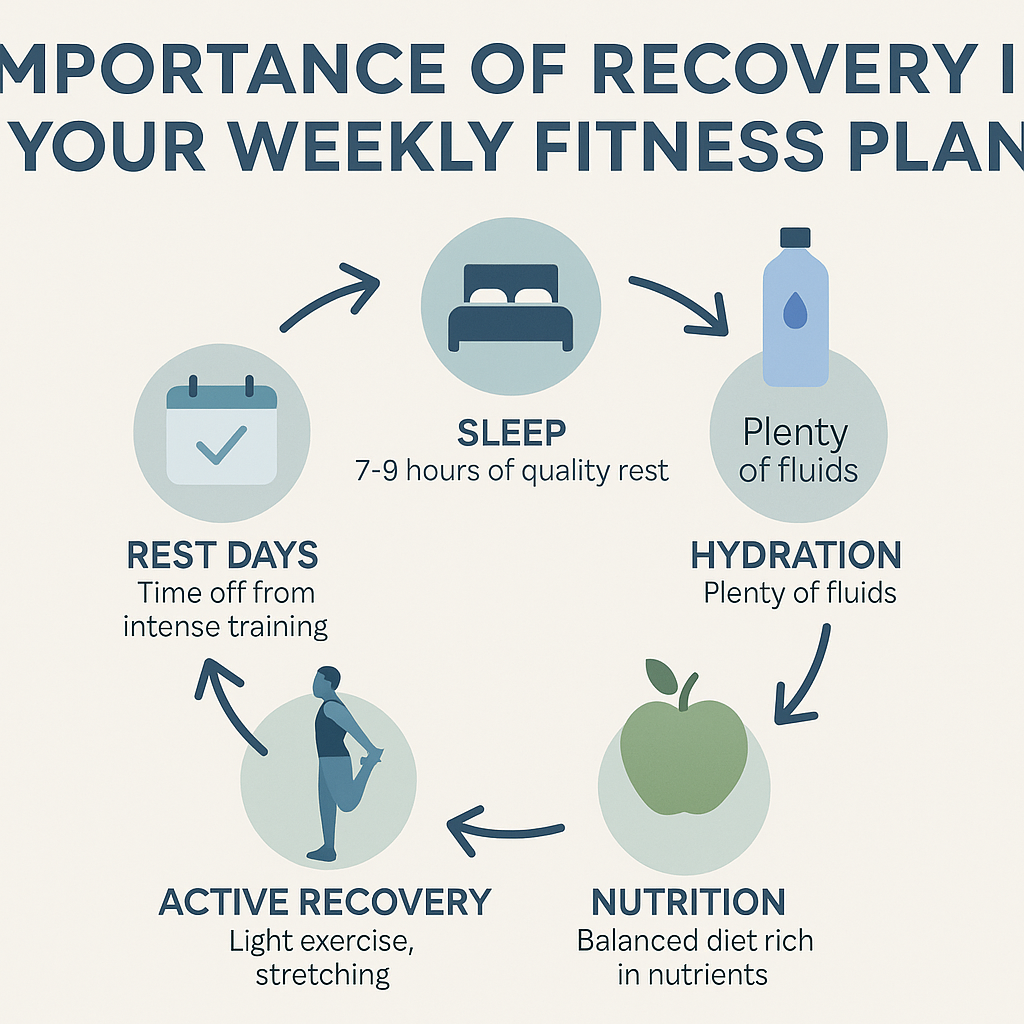Introduction: Why Integrating Running and Strength Training Is Essential for Performance
In the evolving landscape of fitness and athletic performance, the integration of running and strength training has emerged as a foundational strategy for achieving both endurance and muscular development. Crafting a smart, sustainable running and strength training weekly schedule can significantly elevate your performance, improve recovery, and reduce the risk of injury. For runners looking to gain a competitive edge or simply enhance their overall physical conditioning, combining aerobic and resistance training is not just beneficial—it’s essential.
The traditional view that strength training may hinder endurance is now outdated. Modern research and professional practice demonstrate that properly synchronized strength workouts complement a runner’s cardiovascular efforts, resulting in enhanced muscle coordination, joint stability, and metabolic efficiency. Furthermore, thoughtful weekly planning allows athletes to maximize adaptation from both training modalities without compromising either. This comprehensive guide will explore how to build the most effective weekly plan, integrating the best strength workouts for runners and customized resistance training for runners programs with structured running efforts.
Whether you’re preparing for a marathon, recovering from injury, or simply seeking to optimize your overall fitness, this article will provide you with advanced guidance. By the end, you will understand how to structure a running and weightlifting schedule that supports long-term athletic goals and adapts to changing fitness levels. Let’s unlock the science, strategy, and execution behind a powerful and well-aligned training routine.
You may also like: The Ultimate 30-Day Workout Plan for Men Working Out in the Gym: Proven Full Body Strength Exercises to Maximize Results
The Science Behind Strength Training for Runners
Understanding the physiology behind strength training is key to grasping its benefits for runners. At a cellular level, strength training stimulates muscle fibers, particularly Type II fibers, which are essential for power generation and sprinting capacity. While running primarily engages Type I slow-twitch fibers for endurance, incorporating a lifting program for runners helps develop a more robust and resilient musculoskeletal system.
From a biomechanical standpoint, strength training enhances neuromuscular coordination and motor unit recruitment, improving running economy. This means that for the same level of exertion, a trained runner can maintain faster paces or extend duration more efficiently. More importantly, it corrects muscular imbalances that commonly plague runners, such as weak glutes, tight hip flexors, or underdeveloped hamstrings.
Recent studies confirm that strength training reduces injury rates among distance runners by reinforcing joint integrity and increasing bone density. It also fosters metabolic adaptations that support fat oxidation and delay fatigue, critical for long-distance events. A structured strength plan for runners often includes compound lifts, plyometrics, and stabilization work, designed to mimic the dynamic demands of running.
As athletes transition into competitive seasons or high-volume training phases, the right strength training routine for runners serves as both a performance enhancer and a protective measure. Periodization—the systematic variation of volume and intensity—ensures that gains are preserved while avoiding overtraining. Thus, incorporating the right balance of running strength training into your routine provides not only short-term performance gains but also long-term athletic longevity.

Building the Foundation: Structuring Your Weekly Schedule
Creating an effective running and strength training weekly schedule begins with understanding your unique goals and physical capacity. Whether you aim to run a 5K or complete a marathon, the structure must reflect your current fitness level, available time, and performance aspirations. The key is to align the volume and intensity of each component so that they complement rather than compete.
For most runners, three to five days of running combined with two to three days of strength training offers a balanced approach. Beginners might start with alternating days, while seasoned athletes can handle double sessions if recovery is prioritized. A running plan with strength training should always account for at least one complete rest or active recovery day.
The schedule can be periodized to match the training cycle—base building, peak intensity, or taper. For example, during base building, volume is emphasized, so strength workouts may focus on hypertrophy and foundational lifts. During peaking, intensity rises, requiring shorter but more explosive strength sessions to avoid cumulative fatigue. This dynamic interplay between training modes is crucial for maximizing gains.
Careful attention should be given to recovery timing, especially after hard workouts. Placing a resistance training for runners program on the same day as a high-intensity run allows for more complete rest on alternate days. Additionally, ensuring proper nutrition, hydration, and sleep fortifies the recovery process and supports muscular adaptation. By planning strategically, runners can avoid common pitfalls such as overtraining and plateauing.

Running and Strength Training Weekly Schedule for Maximum Gains
Developing a well-structured running and strength training weekly schedule requires aligning training modalities for synergy rather than competition. An ideal week should balance hard and easy days, ensure recovery, and include both aerobic and anaerobic elements.
A sample weekly schedule might include:
- Monday: Moderate-intensity run + upper body strength workout
- Tuesday: Interval run + core and stability training
- Wednesday: Rest or active recovery (light mobility work)
- Thursday: Tempo run + lower body resistance training
- Friday: Easy run or cross-training (bike or swim)
- Saturday: Long endurance run
- Sunday: Rest or full-body strength training
This setup illustrates the key principle of concurrent training: training both systems without compromising the effectiveness of either. A thoughtfully designed running and weightlifting schedule ensures that strength sessions do not impair endurance training quality and vice versa.
Emphasis should be placed on specificity—tailoring the resistance exercises to movements and muscles involved in running. Functional strength workouts for runners include exercises like lunges, step-ups, Romanian deadlifts, and glute bridges. Each session should also include warm-ups, mobility drills, and post-session stretching to maintain movement quality.
Adjustments to this plan may be required based on training phase, race goals, or life stress. Flexibility is essential. Athletes training for a marathon, for instance, may taper strength volume two to three weeks before race day to focus on peak running performance. Monitoring fatigue and using heart rate variability can also inform adjustments to your weekly plan.

Key Components of a Runner’s Strength Training Program
A comprehensive strength training program for runners should address four primary components: muscle endurance, explosive power, joint stability, and functional mobility. By incorporating exercises that target these areas, runners can improve their stride efficiency, increase top-end speed, and enhance overall resilience.
Muscle endurance is foundational, particularly for long-distance runners. High-repetition, moderate-load exercises build the muscular stamina needed to sustain effort across miles. Incorporating supersets or circuit training within the workout plan for runners promotes time efficiency while maintaining aerobic engagement.
Explosive power, though often overlooked by endurance athletes, contributes to improved stride frequency and ground contact time. Exercises such as box jumps, kettlebell swings, and medicine ball throws develop fast-twitch muscle fibers that enhance speed and agility. These movements should be performed at the beginning of a session, when the neuromuscular system is freshest.
Joint stability is critical for injury prevention. Strength training for marathon runners should include single-leg exercises like Bulgarian split squats and single-leg deadlifts to enhance proprioception and balance. Core work, including anti-rotation exercises and planks, also reinforces stability through the kinetic chain.
Functional mobility ensures that strength gains translate into improved running mechanics. Dynamic stretches, foam rolling, and mobility drills should be embedded in the training routine. This holistic approach ensures that the runner’s strength gains improve, rather than impair, running performance.

Periodizing Your Training for Performance Peaks
Periodization is the strategic planning of training cycles to optimize performance at key moments, such as races or peak training blocks. By manipulating training volume, intensity, and frequency, runners can maximize adaptation while minimizing fatigue and injury risk.
In the context of a strength training program for runners, periodization involves transitioning through phases: adaptation, building, intensification, and taper. Each phase has distinct goals. During the adaptation phase, athletes focus on movement quality, light loads, and developing training habits. As they move into the building phase, volume and complexity increase, incorporating compound movements and longer running efforts.
The intensification phase involves pushing thresholds, both in running speed and lifting loads. This period often includes tempo runs, hill repeats, and maximal strength efforts in the weight room. Tapering, typically occurring two to three weeks before an event, reduces training load while maintaining intensity to allow full recovery and peak performance.
Integrating periodization into your running and strength training weekly schedule ensures continuous progress and minimizes plateaus. It also provides psychological variety, preventing burnout and sustaining motivation. Using a journal or app to track sessions, energy levels, and performance can help refine future training cycles.

Customizing Your Running and Weightlifting Schedule
No two runners are alike, which is why a one-size-fits-all approach seldom works. A customized running and weightlifting schedule considers age, training history, lifestyle, and goals. For beginners, the focus may be on building basic movement competency and aerobic base. For experienced athletes, specificity and intensity take precedence.
Time availability is another major factor. Those with limited time may benefit from combined run and weights workout sessions, where resistance training follows a short tempo or interval run. This approach consolidates training and allows for extended recovery windows on alternate days.
Age and injury history should inform exercise selection and volume. Older athletes or those recovering from injury might benefit from reduced plyometric volume and an emphasis on stability and mobility work. Meanwhile, younger runners with aggressive race goals may prioritize progressive overload and compound lifts in their runners weight lifting program.
Flexibility within the schedule is also important for accommodating unexpected changes, such as work commitments or illness. A modular training plan, with optional sessions and adjustable intensities, provides structure without rigidity. Communication with coaches or using wearable tech for feedback further enhances customization.
Essential Strength Exercises for Marathon Runners
When training for long-distance races, specificity becomes paramount. Strength exercises for marathon runners should reinforce endurance mechanics, target running-specific muscles, and build injury resilience.
Key exercises include:
- Deadlifts: Build posterior chain strength, crucial for powerful hip extension.
- Step-ups: Mimic running mechanics and improve unilateral leg strength.
- Hip thrusts: Activate glutes, a common weak point in distance runners.
- Calf raises: Strengthen lower legs to prevent Achilles and plantar fascia injuries.
- Planks and side planks: Stabilize the core and reduce lateral trunk movement during long runs.
Each exercise should be performed with controlled form and progressive loading. Volume can range from 3-4 sets of 8-15 reps depending on the phase of training. Including isometric holds or tempo variations increases time under tension, promoting muscular endurance.
Integrating these exercises into your strength training plan for runners ensures balanced development and translates directly to improved running economy. Whether done in a gym or at home with bodyweight or resistance bands, these movements are versatile and effective.

The Role of Recovery in Your Weekly Plan
Recovery is not a passive process; it’s an active part of a successful running and strength training weekly schedule. Without adequate recovery, the body cannot adapt, grow stronger, or perform optimally. Recovery strategies must be deliberately included in the training plan to ensure consistency and long-term progression.
Physiologically, training creates microtrauma in muscles and stresses energy systems. Recovery allows these systems to repair, replenish, and grow stronger. Key recovery elements include sleep, nutrition, hydration, and active recovery practices like yoga, foam rolling, or light aerobic activity.
Rest days should be respected, not skipped. Overtraining often stems from neglecting recovery, leading to fatigue, decreased performance, and injury. Strategic placement of rest days after high-intensity sessions or long runs enhances supercompensation—the body’s ability to rebound stronger after a stressor.
Tools such as heart rate variability monitors, sleep trackers, and perceived exertion scales help quantify recovery. They provide actionable insights to guide training intensity and volume. Psychological recovery, including stress management and mindfulness, also plays a role in sustaining motivation and preventing burnout.
Incorporating recovery into your weekly workout plan for runners is not a sign of weakness, but a mark of maturity. It reflects an understanding of the training-recovery cycle and maximizes both short- and long-term performance potential.

Frequently Asked Questions: Enhancing Your Running and Strength Training Weekly Schedule
1. What are the most overlooked elements in a running and strength training weekly schedule?
Many runners focus exclusively on cardio volume and traditional lifts but overlook neuromuscular training, sleep hygiene, and gait analysis. Neuromuscular conditioning, including drills like high knees, A-skips, and lateral hops, enhances stride mechanics and can be layered into a run and weights workout without taxing the recovery system. Similarly, consistent, high-quality sleep is crucial for endocrine regulation and muscle repair, yet it’s frequently underestimated. Incorporating gait analysis every few months also helps identify asymmetries and inefficiencies that could compromise both strength gains and running form. These elements, when thoughtfully included in a running and strength training weekly schedule, round out a comprehensive, performance-optimized approach.
2. How can runners avoid overtraining when combining strength and endurance work?
Balancing the intensity and frequency of each workout is critical. One effective approach is implementing polarized training, which separates low-intensity aerobic runs from high-load lifting sessions. Utilizing a strength training plan for runners that prioritizes movement quality over maximal load can prevent neuromuscular burnout. Monitoring biomarkers such as resting heart rate, HRV (heart rate variability), and even mood can help preemptively identify signs of overtraining. Including one complete rest day per week, and alternating lower-body lifts with upper-body or core focus, helps distribute training stress evenly without compromising performance.
3. What role does nutrition play in optimizing a lifting program for runners?
Nutrition is foundational to the success of any lifting program for runners, particularly when juggling dual goals of endurance and hypertrophy. Timing macronutrients strategically—such as consuming carbohydrates post-run and protein-rich meals after strength training—enhances recovery and muscle synthesis. Omega-3 fatty acids from sources like flaxseed and salmon help reduce inflammation from high-volume training. Electrolyte balance, especially sodium and magnesium, should be managed to prevent cramps and fatigue during peak training weeks. A registered dietitian familiar with runners weight lifting program demands can personalize intake strategies for race prep or strength cycles.
4. How can marathon runners adapt their strength routine as race day approaches?
Marathon runners should taper their strength training volume 2-3 weeks before race day, focusing instead on mobility, core activation, and neuromuscular readiness. Strength for runners in this phase prioritizes muscle activation and injury prevention rather than gains in mass or power. Incorporating mobility circuits and low-load exercises like resistance band work enhances circulation and primes neuromuscular coordination. Recovery techniques such as contrast baths, compression therapy, and sports massage can complement tapering. Importantly, runners should avoid new lifts or drastic changes to their runners weight lifting program during this final phase to prevent unnecessary soreness.
5 .How do you modify a running and weightlifting schedule for older athletes?
For masters athletes, joint integrity and recovery become paramount. A running and weightlifting schedule for older runners should include extended warm-ups, joint-friendly strength work (e.g., resistance bands and kettlebells), and greater rest between sessions. Strength training for marathon runners in this demographic may lean more heavily on eccentric loading and stability training to protect tendons and ligaments. Older athletes also benefit from high-protein diets and possibly collagen supplementation to support connective tissue health. Cross-training methods like rowing and elliptical work can substitute for high-impact runs on recovery days to reduce cumulative joint stress.
6. How do psychological strategies impact a strength training routine for runners?
Mental training is often the missing link in athletic programs. Visualization techniques can be employed before challenging strength sessions to enhance performance and focus. Developing mindfulness through practices like breathwork or meditation helps manage anxiety before key workouts and races. Setting micro-goals within a strength training routine for runners (such as improving tempo in a specific lift or mastering a new plyometric drill) provides ongoing motivation. Celebrating small victories also reinforces positive associations with consistent training. Over time, this mindset shifts training from a chore to a form of self-mastery.
7. How can strength exercises for marathon runners be adapted during injury rehab?
Injury doesn’t have to derail progress. Strength exercises for marathon runners undergoing rehab can be modified to include isometric holds, aquatic resistance work, or single-leg stability drills. For example, a sprinter with Achilles tendinitis might replace lunges with resistance band leg curls to reduce impact. A resistance training for runners program during rehab often involves close coordination with physiotherapists, who can tailor loading protocols to healing timelines. The key is to maintain neural activation and muscle tone while avoiding further strain. Post-recovery, gradually reintroducing bilateral compound lifts rebuilds symmetrical strength and confidence.
8. Why is it important to include variability in your strength training program for runners?
Human movement thrives on variety. A strength training program for runners that includes different modalities (barbells, dumbbells, bodyweight, and suspension training) challenges the body in unique ways, fostering adaptability and reducing injury risk. Changing grip position, stance width, and range of motion can elicit new motor unit recruitment. Seasonal variability, such as focusing on hypertrophy in winter and neuromuscular power in spring, also aligns with competitive calendars. Runners strength training benefits when the nervous system is stimulated through diverse movement patterns, maintaining engagement and avoiding stagnation.
9. What are the long-term benefits of a consistent weight training routine for runners?
Beyond immediate gains in performance and injury resistance, a consistent weight training routine for runners contributes to lifelong mobility, metabolic efficiency, and bone health. Especially as runners age, strength training preserves lean muscle mass and supports hormonal balance. It also builds resilience against falls and fractures, which become more prevalent in older populations. From a psychological standpoint, maintaining strength fosters autonomy and confidence well beyond athletic peak years. Ultimately, a well-structured weight lifting plan for runners lays the groundwork for healthspan—the period of life spent in good health.
10. How can a running and strength training weekly schedule support high-performance lifestyles?
A carefully calibrated running and strength training weekly schedule supports busy professionals, competitive athletes, and fitness enthusiasts alike. Time-blocking techniques can allocate morning sessions to fasted aerobic work and evening hours to resistance sessions, maximizing hormonal rhythms. Including minimalist strength routines on business trips (using hotel gyms or bodyweight protocols) preserves consistency. A running plan with strength training also enhances cognitive function, focus, and energy, which spill over into workplace productivity. Over time, these compound effects create a feedback loop where physical health fuels professional success, and vice versa.
Conclusion: Your Path to a Balanced and High-Performance Training Routine
Achieving peak fitness requires more than just effort—it demands intelligent planning, strategic execution, and a commitment to the process. By designing a running and strength training weekly schedule that aligns with your goals, physiology, and lifestyle, you can unlock new levels of endurance, strength, and resilience.
From building a foundational base to fine-tuning for race day, every aspect of your plan matters. Whether you are incorporating the best strength workouts for runners or tailoring a weight lifting plan for runners, the key is intentional integration. Understand the purpose of each session, listen to your body, and make adjustments when needed.
Sustained progress comes from consistency, variety, and recovery. A well-structured program empowers you to push limits without risking breakdown. With the insights and strategies provided here, you have a roadmap to guide your journey.
Let this article serve as your blueprint. Use it to craft a running and strength training weekly schedule that not only challenges you but also sustains you. The path to athletic excellence is not paved with shortcuts, but with thoughtful, deliberate steps—and now, you’re ready to take them.





